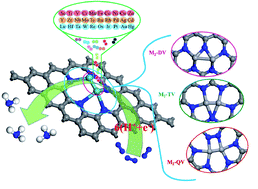Dual transition metal atoms embedded in N-doped graphene for electrochemical nitrogen fixation under ambient conditions†
Abstract
A systematic study on the catalytic performance of dual transition metal atoms (3d, 4d and 5d) embedded in three types of N-doped graphene (DV, TV, QV) for electrocatalytic nitrogen reduction reaction (NRR) was conducted by first-principles calculations, high-throughput screening and molecular dynamic simulations. Full reaction pathway search of the screened candidates shows Cr2-TV, Mo2-TV and Ir2-TV to be the promising catalysts for NRR with onset potentials of −0.24, −0.39 and −0.38 V, respectively. In-deep analysis of the band structure, projected density of states, spin density, charge density difference, Bader charge population of N2 molecule adsorbed on catalysts unveil that the charge transfer between the adsorbed N2 molecules and the metal atoms in catalysts, good electronic conductivity, and significant orbital hybridization account for the high catalytic efficiency of NRR on Cr2-TV, Mo2-TV and Ir2-TV. The evaluation of stability and selectivity of the three catalysts indicates that all three catalysts display high stabilities, and Cr2-/Mo2-TV shows good NRR selectivity compared to HER. Our present study sheds some insights on the design of novel dimetal anchored N-doped graphene as efficient electrocatalysts for NRR, promoting both experimental and theoretical investigations in this direction.



 Please wait while we load your content...
Please wait while we load your content...